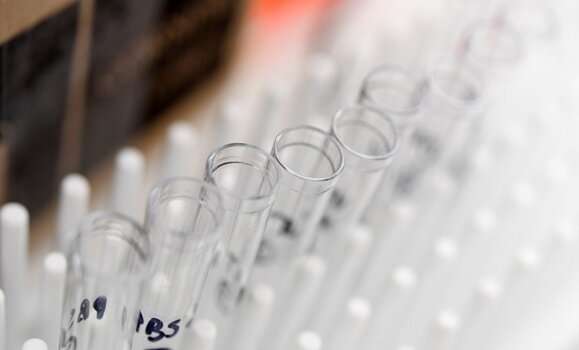
Researchers at Dalhousie University have helped in the development of a rapid test to detect the presence of SARS-CoV-2 in wastewater—an unexpected resource that is becoming a valuable sentinel in the global fight to contain the virus before it is able to spread.
Amina Stoddart, an assistant professor in the Department of Civil and Resource Engineering, is leading a project with colleagues Graham Gagnon and Rob Jamieson to develop a wastewater-based surveillance approach for COVID-19.
They are working with Halifax Water and LuminUltra Technologies, a Canadian biotechnology company which recently filed a patent for the first complete rapid, on-site COVID-19 wastewater testing solution.
Central to the approach is the idea that wastewater could alert officials to the presence of the virus either before someone develops symptoms or receives a positive test result or if they are asymptomatic.
“Wastewater testing has been shown to lead to early identification of the virus before it is known in a clinical context—the potential benefit could help Public Health leaders with additional information for decisions concerning the pandemic,” said Dr. Stoddart.
“Public health leaders around the world have validated that wastewater testing is a powerful tool in the fight against the pandemic, and global research leaders have demonstrated the benefits of testing human waste in controlled populations. We are very pleased to continue Dalhousie’s long-standing research relationship with LuminUltra to help fight the COVID-19 pandemic in Halifax and beyond.”
SARS-CoV-2 RNA detected in waste
The genetic code, or RNA, from SARS-CoV-2 has been found in the feces of people infected with the virus and it is known that the particles survive longer in the gastrointestinal tract than in the respiratory tract. Because of that, wastewater may be monitored for SARS-CoV-2 to determine the prevalence of COVID-19 infections in a given population.
In Spain, for example, researchers detected COVID-19 in 83 percent of untreated wastewater samples before initial cases were reported in the region.
Ultimately, the innovation in the RNA extraction and concentration process resulting from the team’s research has eliminated the need for additional complicated equipment, greatly simplifying the process from sample collection to result.
“Halifax Water is pleased to be a partner in this important research project. It is a natural extension of our history of supporting innovative research in water and wastewater for the benefit of customers and the environment,” says Halifax Water General Manager Cathie O’Toole.
LuminUltra Technologies has developed a range of Environmental Monitoring Solutions to detect the presence of the SARS-CoV-2 virus in environments, including surfaces, air, water and wastewater. They are the developer of the GeneCount qPCR system, which allows customers to do rapid, on-site environmental testing.
“The idea of wastewater surveillance testing has been advocated by researchers around the world since the onset of the COVID-19 pandemic,” said Pat Whalen, president and CEO of LuminUltra.
“Until now, wastewater testing has been complicated, expensive and time consuming—meaning the potentially life-saving technique was reserved for niche subgroups under the watchful eye of researchers. We have been determined to make this surveillance tool more accessible to communities everywhere, allowing for a game-changing early warning of COVID-19 infections.”
Leading-edge research and training
The team will quantify the SARS- CoV-2 load in the raw wastewater with the goal of identifying occurrence in the community. The collaborative work itself has both immediate and long-term benefits, says Dr. Gagnon.
“I am very pleased that the partnership between LuminUltra and Dalhousie has led to this innovation, but extraordinarily proud that the partnership has fostered leading-edge research training opportunities for post-docs and graduate students, like Dr. Ana Luisa Parra (post-doctoral fellow), Emalie Hayes (MASc student), and Rishab Monga (BEng Coop student) at Dalhousie,” he said.
LuminUltra’s wastewater testing solution allows communities and controlled populations to analyze overall population health, rather than relying solely on single-patient clinical tests to determine if there is an infection of COVID-19 present or a surge in cases. The City of Moncton, N.B., has recently begun collecting wastewater samples to evaluate the potential of using the technology as a predictive index in the management of COVID-19 and public health messaging.
“LuminUltra has supported research at Dalhousie for over a decade and this latest innovation is a shining example of the great work that has occurred over this time,” says Dr. Gagnon.
The wastewater research builds upon a long-standing water research partnership that has been in place since 2007 between Dalhousie University and Halifax Water through the NSERC Halifax Water Industrial Research Chair. This partnership has developed industry leading research on Lead Service Line Replacements and other water quality improvements.
Their findings will be shared with the NSHA to potentially help it make public health decisions related to identifying the extent of infection in Nova Scotia, early detection of subsequent waves of the virus and informing the safe lifting of social and economic restrictions.
Samples will initially be collected from Halifax Water wastewater treatment facilities in Dartmouth and Halifax, with the possibility that the project could be expanded throughout the province. The team will quantify the SARS- CoV-2 load in the raw wastewater with the goal of identifying occurrence in the community.
Last March, Halifax Water and Dr. Stoddart were awarded a three-year Natural Sciences and Engineering Research Council (NSERC) Collaborative Research and Development grant worth $1 million to support wastewater research focused on surveillance and treatment strategy development. The wastewater research builds upon a long-standing water research partnership that has been in place since 2007 between Dalhousie University and Halifax Water through the NSERC Halifax Water Industrial Research Chair.
Source: Read Full Article
